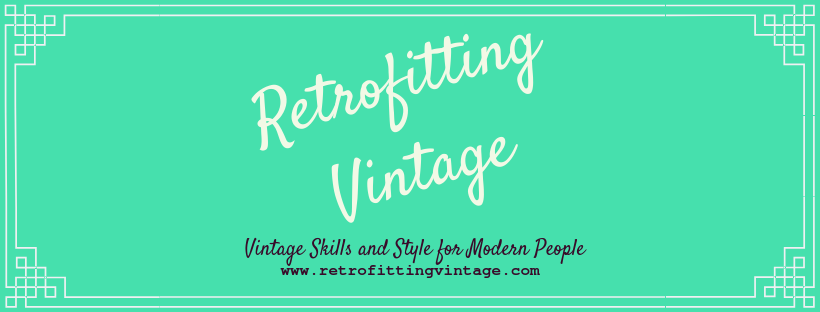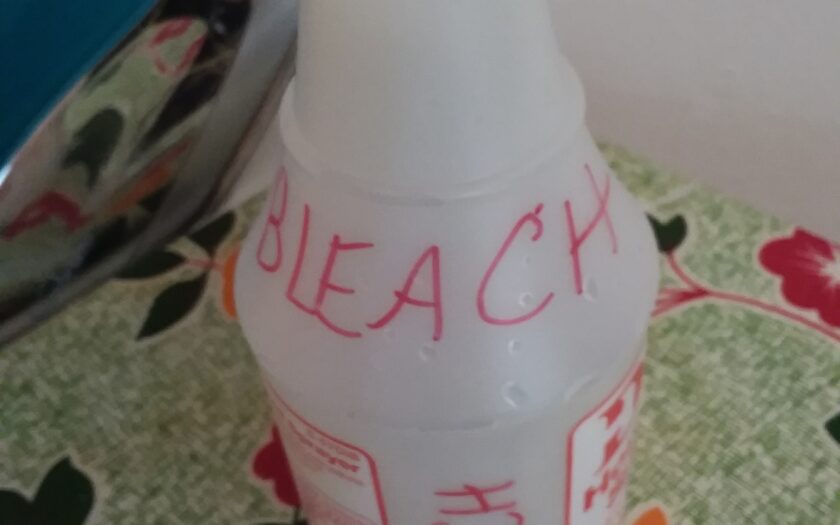If there’s one substance most associated with “old-fashioned” cleaning, it’s bleach. Throughout the 20th century, homemakers relied on bleach for its powerful germ-killing abilities.
And, despite a mild obsession with 20th-century homemaking, I almost never use it.

I didn’t grow up cleaning with bleach, I hate the smell, and it’s always seemed…scary. It’s poisonous and corrosive, both things I generally try to avoid.
But we live in interesting times, my friends, and the coronavirus has caused me to investigate, and ultimately, change my position. I decided to learn how to disinfect my household with bleach.
“But Vinegar is a Natural Disinfectant!”
That’s true! Vinegar kills a lot of stuff. Just not all the stuff. It’s not the best at killing viruses, and in this instance, I am not prepared to mess around.
I love my vinegar and baking soda as much as the next person, but when we’re talking sheer germ-killing power, they really can’t compare with the power of bleach.
Usually, there’s an argument to be made against over-disinfecting, as that is the way to super germs and such, but in this case, disinfecting is warranted and recommended.
What is Bleach?
Household bleach is a sodium hypochlorite solution. It’s made from a mix of salt and water that is transformed by a direct current of electricity to produce chlorine and sodium hydroxide, which then react to make bleach. When it is used, it eventually reverts back to salt and water. (That’s why using bleach properly isn’t harmful to groundwater.)
Does Bleach Kill Coronavirus?
Yes, it does. The CDC says that unexpired, properly diluted household bleach kills the virus on nonporous surfaces. This is good news, because it can live quite awhile on such surfaces otherwise.
During an epidemic (or just during a normal cold and flu season) it’s wise to frequently disinfect the high-touch areas of your home like doorknobs, handles, light switches, faucets, toilets, chairs, counters, and table surfaces.

Bleach Use For Beginners: Precautions
Bleach is dangerous, which is why you should follow some commonsense precautions.

- Don’t mix it with…anything besides cool water. Especially do not mix it with ammonia, which will result in poison gas that can kill you.
- Read and follow all instructions on the container.
- Obviously, don’t consume it.
- Keep it off your skin, and away from your eyes, mouth, and nose.
- Store it away from children, preferably somewhere locked
- Wear gloves when handling
- Open a window, or otherwise ventilate the area
- Label the container you mix your solution in (America’s Housekeeping Book suggests over-labeling anything poisonous in your home, including putting a bell around the bottleneck or a pin in the cork, so you can even tell it’s poisonous in the dark!)
- Dilute, dilute, dilute.
- Keep it off your clothes (except for sanctioned laundry use), it will ruin them.
Getting To It: Cleaning Surfaces
First off, you can’t actually clean with bleach. You can disinfect (and remove stains). That’s the superpower. So first, clean the surface you’re going to disinfect with soap and water. Rinse well, to avoid accidentally mixing chemicals.

Step 1: Dilution
Determine what kind of bleach you’re dealing with. For general purposes, we’re talking unscented, not super-concentrated or otherwise special, unexpired chlorine bleach.
For killing coronavirus on nonporous surfaces, the CDC recommends a ration of 1/3 cup (5 TB) bleach per gallon of water, or 4 teaspoons bleach per quart of water. Other general cleaning recommendations suggest up to half a cup of bleach per gallon of water. I’m going to err on the side of less/what the CDC tells me does the job.
More is not more in this case–follow the dilution instructions and the germs will die.
Step 2: Clean the Surface
Wash the (nonporous) surface with soap and water. Rinse with water thoroughly. Dry.
Step 3: Disinfect with Bleach
Cover the surface with the bleach solution (I use it in a clean spray bottle), allow the it to sit for about five minutes.
Step 4: Rinse with Water
Self-explanatory? Rinse the surface with water.
Step 5: Allow to Air Dry
The air drying is important because it stops you from re-contaminating the thing you just disinfected.
Sanitizing Nonporous Objects
Okay, so what about plastic toys your toddlers are mouthing and drinking glasses that sick people used and the like? Mix two (2) teaspoons with a gallon of cool water, soak the items for two minutes, then remove and air dry, no rinsing necessary.
Go Forward with Confidence
This is a weird time. There’s a lot that we don’t know, and much to be anxious about. I’m finding that cultivating simple knowledge of how to do things to protect myself and my loved ones is grounding, and maybe you will, too.

